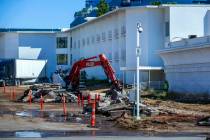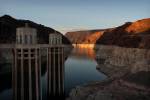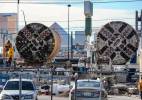Dig this trip into hot tunnel project
The trip underground takes 3½ minutes in an elevator built to carry up to 22 people.
If you turned the Aria upside down and buried it, this would be a ride to the penthouse.
And you’re not even there yet.
It takes real work to get to the end of the new water intake now under construction at Lake Mead, a project some have called the most complicated tunneling job on Earth.
From the elevator, you descend a flight of stairs and climb inside a metal box on wheels for another three-minute ride, this time on a small railroad built 600 feet below ground.
The rails carry you through a 20-foot-tall concrete pipe now roughly two-thirds of a mile long and still more than two miles from completion.
At the end of the line, the train angles upward slightly as it drives onto the rear of the massive tunnel-boring machine — 600 feet long and as heavy as 300 elephants — that was specially built in Germany to dig the Southern Nevada Authority’s new straw into the lake.
You’ll be sweating long before you get there.
A COMMUNITY LIFELINE
Once finished, the third intake is expected to keep water flowing to Las Vegas even if Lake Mead shrinks low enough to leave one of the community’s two existing straws high and dry.
The surface of the reservoir now sits at 1,106 feet above sea level. The latest federal projections call for it to drop 25 feet over the next year, to a record low not seen since Hoover Dam was finished and Lake Mead was filled for the first time.
If the lake keeps falling like it is, the authority could lose the use of intake No. 1 sometime in late 2015, when the reservoir hits the 1,050-foot mark.
The valley draws 90 percent of its drinking water from the lake.
The third intake is scheduled for completion by the end of next summer, but it’s “unlikely” that general contractor Vegas Tunnel Constructors will be done by then, says engineer Erika Moonin, project manager for the water authority.
She declines to speculate when it might be finished, except to say that “we’re confident we’ll get the project done and on line before intake No. 1 shuts down.”
The inside of the tunneling machine resembles the engineering space on a ship or submarine, with narrow metal walkways snaking past a maze of pipes, cables, control boxes and electric motors.
There’s machine noise and grime and dripping water, but there’s no sensation of depth or forward movement. You don’t feel the cutter head cutting or the weight of the rock and water looming above your head.
What you feel instead is heat, much of it generated by the grinding of the boring machine itself. A digital thermometer mounted along a metal railing delivers the bad news: 100 degrees. 28 percent humidity.
“Singapore in August,” says water authority spokesman J.C. Davis.
“I spend a lot of time thinking about my pool when I’m underground,” jokes Robin Rockey, the authority’s liaison to the project.
The contractor tries to cool the tunnel with an air conditioning unit big enough to cool most Strip resorts, but it doesn’t do much more than “take the edge off,” Moonin says.
The current mining crew includes about 100 people divided among three shifts. There is work going on underground 24 hours a day, six to seven days a week.
Workers spend their entire shift in the hole, including their lunch breaks.
“No cafeteria,” Moonin says with a laugh.
A RING AT A TIME
As the machine digs, a conveyor belt carries crushed rock back through the tunnel and dumps it into buckets to be lifted up the vertical access shaft to the surface.
One bucket holds 20 cubic yards of material, enough to landscape the yards of four average valley homes. Instead, this rock and dirt is being shaped into a berm that will partially shield the site from view once the third intake is finished.
The material coming out of the hole right now resembles gritty brown mud.
Each time the machine advances, the pipe behind it grows by 6 feet as a new ring of concrete is added just behind the giant digger’s shielded front section.
Each ring is made up of six preformed segments weighing 5 or 6 tons apiece. It will take roughly 2,400 rings to line all three miles of tunnel.
The utility lines, air ducts and conveyor belts that service the boring machine, also must be extended as it inches farther and farther away from the vertical access shaft.
The laser-guided digger is “steered” from a cramped control cabin about 100 feet from the cutter head, where a pair of workers scan a bank of screens and monitor radio traffic from all corners of the work site.
Eventually, the machine will come within about 50 feet of the lake bottom as it tunnels beneath the channel carved by the old Las Vegas Wash back when it flowed all the way to the untamed Colorado River.
The boring machine’s journey will end at an intake structure that Vegas Tunnel Constructors has already built underwater at the edge of the Colorado’s original alignment, now one of the deepest points in Lake Mead.
At $817 million and counting, this is the single most expensive construction project the water authority has ever undertaken.
Already, it has come at a terrible cost.
On June 11, 2012, worker Thomas Albert Turner, 44, was killed in a construction accident inside the tunnel. Stickers with the words “Tommy Turner” printed over the Superman logo decorate the guard shack and several hard hats at the work site.
Moonin says underground mining is such a specialized trade that workers often travel from job to job, forming a tight-knit group, almost like a family.
DEEP UNDER WATER
The project reached a milestone about eight weeks ago, when the machine dug beneath the shore of Lake Mead and tunneled under open water for the first time.
After crossing the shallow tip of Saddle Cove, the boring machine made its way back under dry land, but not for long. In a week or two it will cross the shoreline for the last time and curve gradually to the east for a roughly two-mile run directly beneath the 4 trillion gallon reservoir.
The conditions under the lake shouldn’t be much different than they were next to it. Moonin says the project has been “under the influence” of water almost from the start.
So much water and debris washed into the cavern early on — before the boring machine could be assembled underground — that the contractor had to abandon its first tunnel and dig a new one in a slightly different direction.
What followed was months of painfully slow progress through fractured rock and clay riddled with water-filled gaps that forced the machine to run in “closed mode,” using grout to pressurize the area around the cutter head.
The boring machine finally reached what Moonin calls “good, stable ground” in June and switched to “open mode” for the first time on July 8.
Since then, it has been clipping along at the breakneck pace of about an inch a minute as it carves its way through a uniform block of sedimentary rock that used to be a muddy creek bed roughly 7 million years ago.
After needing roughly 18 months to dig the first 2,850 feet of tunnel, the machine has advanced some 450 feet since early July alone. Monday marked the project’s most productive day yet, with 72 feet of new tunnel mined and 12 new rings added to the pipe.
Moonin hopes the worst ground is now behind them, “but there’s just no way to know with tunneling.”
“We do know there is challenging rock ahead. We won’t know how bad it is until we get there,” she says.
THE WAY OUT
You leave the tunnel the same way you came, only in reverse: A cramped walk back through the machine, then the train, then the elevator .
The noonday sun is blinding at the top of the hole, but the dry air cools your skin. You’ll have to enjoy the feeling someplace else. A man in a hard hat motions to a load of concrete pipe segments suspended from a crane nearby, ready to be lowered down the shaft.
You are in the way.
Contact reporter Henry Brean at hbrean@reviewjournal.com or 702-383-0350.
































